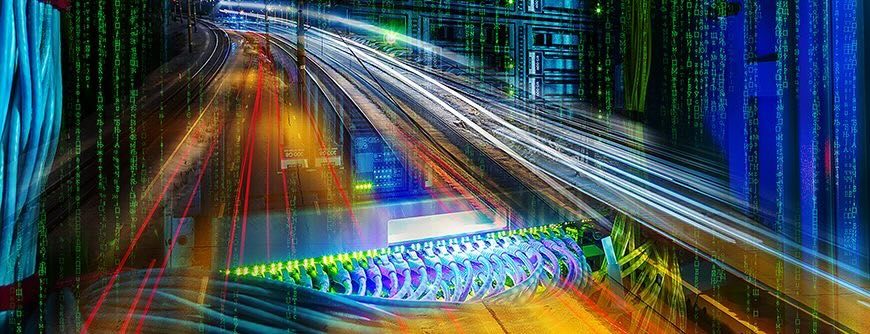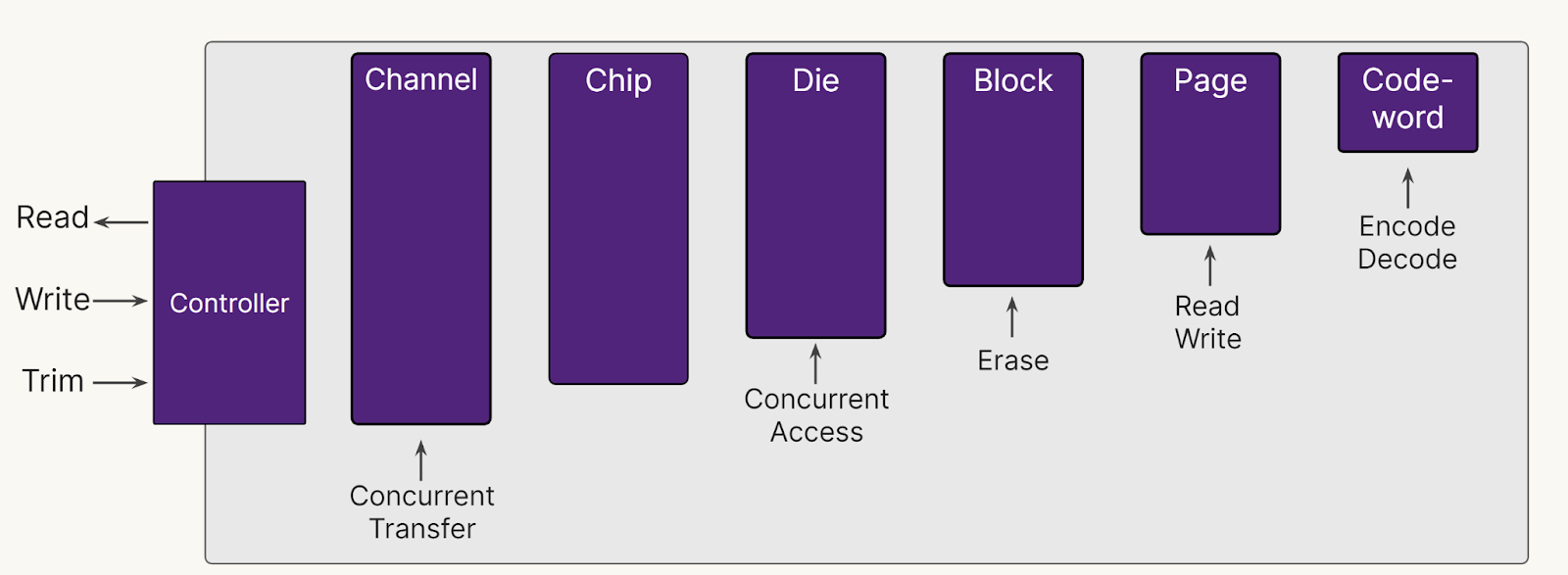但由於您現在正在將新版本的資料寫入不同的快閃頁面中,最終您累積的資料會被視為垃圾,因為資料已被覆寫或邏輯刪除。
垃圾收集機制如何在 SSD 中運作
為了恢復此實體容量,硬碟韌體中的「垃圾收集器」流程會將仍然有效的資料移至新的位置,以便清除包含「整合」資料的整個區塊。為了讓垃圾收集器運作,每部硬碟都需要額外的快閃記憶體,也就是所謂的“預留空間”,而每一場垃圾收集事件都會消耗有限的快閃程式/清除週期。每個邏輯寫入消耗的實體寫入量稱為“寫入放大”。
過度配置和寫入放大會導致 SSD 過早磨損,縮短使用壽命。這樣的設計也會對效能造成影響,因為每當其中一個快閃晶粒進行垃圾收集、讀取或寫入時,都無法從該晶粒取得。因此,隨著垃圾收集器變得越來越活躍,SSD 的效能勢不可擋。
SSD 無法將這個垃圾收集活動傳達給存取系統,讓這個活動更具挑戰性。相反地,SSD 必須保持假想,它就像硬碟一樣。隨著 NAND 快閃記憶體中每個單元的位元數增加,這些效能不一致的情況只會變得更糟,因為程式/清除週期需要較長的時間,導致資料存取時間更長。
使用 DirectFlash 的優勢
DirectFlash 採用不同的快閃媒體管理方法。Purity 作業系統在軟體陣列層級執行這些功能,而不只是將每部 SSD 視為執行自身耗損平衡技術、垃圾收集與超額配置。這表示每個 DirectFlash 模組都比傳統的固態磁碟更簡單,因為它只需要提供媒體本身的存取權限,並處理低階資料和訊號任務。
深入了解 DirectFlash 如何為硬碟(HDD)帶來終端。
這帶來了許多好處:
- 改善密度與效率。 我們的 DirectFlash 模組(DFM)提供比目前最接近的競爭對手高出兩到三倍的儲存密度,每 TB 消耗的瓦數減少了 39% 到 54%。Pure Storage DFM 不會模擬機械式 HDD,因此相較於 COTS SSD,矽基快閃媒體的管理方式可大幅改善效能、儲存密度、有效容量、媒體耐久度,以及每個可用 TB 的成本。Pure Storage 今天出貨 48TB DFM,今年稍晚將增加 75TB DFM,將在 18 個月內增加 150TB DFM,並計劃在 2026 年前增加 300TB DFM。更多資訊。
- 存放智慧資料。Purity 不須在空間內就資料放置和媒體管理做出決策,而是了解所有持續和排程的系統任務,例如目前的 IO 活動、資料減量作業、待定的垃圾收集週期,以及整體陣列工作負載和健全狀況。這讓 Purity 能夠比單一硬碟更聰明地進行配置和排程決策。
- 透過做出更明智的資料配置決策,類似預期壽命的資料可以在同一區塊上並存,以儘量減少區塊中的某些資料被“整合”的情況,而其他頁面仍然有效。Purity 知道某些頁面是屬於同一檔案或物件的一部分,或是來自同一主機系統,因此當刪除該檔案或物件時,將這些頁面分成類似的區塊,即可一次釋放整個區塊,而無需重新寫入其他即時資料,並導致寫入放大。
- 它們的表現優異,效能超前。DirectFlash 模組不進行垃圾收集,且不會造成寫入放大,效能超越其商品。更少的寫入意味著更少的磨損,從而延長使用壽命。更少的寫入也意味著更多的 IO 週期可用於服務“真正的”用戶端 IO。而且因為 Purity 知道目前的 IO 活動,而且能看到整個系統,因此其中一個程式/清除週期會阻止資料存取,這永遠不會讓您感到驚訝。在最壞的情況下,Purity 可以重建資料,而不必等待程式/清除週期完成。即使使用 QLC 快閃,也能大幅降低系統最壞的延遲。
- 隨著時間的推移,它們會有所改善。 因為我們在軟體中執行所有這些媒體管理任務,因此可以隨著時間改進軟體。所有連接到網際網路的 Pure Storage 系統皆能安全地以電話方式傳輸家庭遙測資料,而且由於我們深入了解了底層快閃記憶體的健康與活動,因此我們彙總並分析這些資料,以改善軟體在真實世界的運作方式。這意味著,隨著時間的推移,我們系統的可靠性和效能可以通過定期軟體更新來提高。
- 更簡單、更可靠。 因為我們在軟體陣列層級執行所有這些活動,所以 DirectFlash 模組不需要複雜的控制器和大量的 RAM,就能自行完成這些工作。因此,我們的模組不僅更簡單、更可靠,而且效率更高。我們也能在 NAND 快閃記憶體製造技術的進步下,擴充硬碟規模,而不需增加硬碟複雜度或成本。
這表示,與其他以 SSD 為設計基礎的全快閃或混合系統相比,系統效能更高、更一致、可靠性更高、壽命更高。
Pure Storage 的成立理念是資料中心的未來全快閃,而我們建立了 DirectFlash 技術,讓願景成真。我們相信,打造全快閃系統的最佳方式,就是從頭開始打造全快閃系統。這意味著要消除以傳統介面和範例為設計基礎的系統零件,讓技術真正閃耀。
想要在您的資料中心運用 DirectFlash 技術嗎? 立即查看我們的全快閃儲存解決方案套件。



